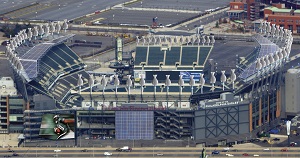Philadelphia Eagles stadium on track to be self-sustaining
 While dozens of professional sporting facilities around the country have recently announced solar and other clean energy projects, the Philadelphia Eagles is the first to announce plans to become completely self-sustaining.
While dozens of professional sporting facilities around the country have recently announced solar and other clean energy projects, the Philadelphia Eagles is the first to announce plans to become completely self-sustaining.
The Eagles announced earlier this week that it would install wind, solar and cogeneration power systems on its Lincoln Financial Field in order to get 100 percent of its energy from on-site renewable sources.
The club already purchased 100 percent clean energy through a credit program, Eagle COO Don Smolenski said. But this program takes the club’s dedication to environmental stewardship and community involvement to the next level.
When the season starts September 2011, The Lincoln Financial Field will be home to 80 spiral wind turbines, 2,500 photovoltaic solar panels and a 7.5-megawatt natural gas and biodiesel cogeneration system, according to a press release from the club.
The combined systems are expected not only to produce all of the energy the club needs, but also to send 4 megawatts of power back into the electricity grid during the team’s off-season, according to the release. It will generate enough energy to power 26,000 homes.
The $30 million project is a partnership with Solar Blue.
Smolenski said the club consulted with a number of different companies about installing a 100 percent self-sustaining energy system and liked Solar Blue’s plan the best.
“It seemed to really work with the aesthetics of the facility,” he said.
This new and deep commitment to clean energy had been building over the years until it reached this apex, Smolenski said.
“In some respects, this project is a natural outgrowth of the journey we started in 2003,” he said, “without ‘go green initiative.’”
That program started small—encouraging recycling and changing the way the club dealt with its own waste.
The club started buying clean energy credits to offset its own use, Smolenski said. About a quarter of the club’s energy was offset with clean credits by the end of 2003. By the end of 2008, all of the club’s power was accounted for. The Eagles also added solar panels to Lincoln Financial Field around that time.
The timing was right for a big change like this, Smolenski said. Not only are there some rich federal and state incentives this year, but also Pennsylvania’s deregulation of utilities opened up options, Smolenski said.
“I think this, for us, reflects our commitment to community and to give back,” Smolenski said. “We’re excited about it.”
Pictured: An artist's rendering of the future Lincoln Financial Field, complete with solar panels, wind turbines, and one gigantic, unstoppable, 100-foot player.



